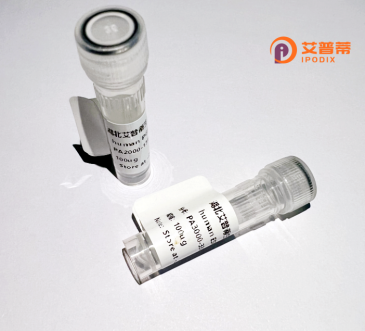
| 纯度 | >90%SDS-PAGE. |
| 种属 | Human |
| 靶点 | NAGS |
| Uniprot No | Q8N159 |
| 内毒素 | < 0.01EU/μg |
| 表达宿主 | E.coli |
| 表达区间 | 1-534aa |
| 氨基酸序列 | MATALMAVVLRAAAVAPRLRGRGGTGGARRLSCGARRRAARGTSPGRRLSTAWSQPQPPPEEYAGADDVSQSPVAEEPSWVPSPRPPVPHESPEPPSGRSLVQRDIQAFLNQCGASPGEARHWLTQFQTCHHSADKPFAVIEVDEEVLKCQQGVSSLAFALAFLQRMDMKPLVVLGLPAPTAPSGCLSFWEAKAQLAKSCKVLVDALRHNAAAAVPFFGGGSVLRAAEPAPHASYGGIVSVETDLLQWCLESGSIPILCPIGETAARRSVLLDSLEVTASLAKALRPTKIIFLNNTGGLRDSSHKVLSNVNLPADLDLVCNAEWVSTKERQQMRLIVDVLSRLPHHSSAVITAASTLLTELFSNKGSGTLFKNAERMLRVRSLDKLDQGRLVDLVNASFGKKLRDDYLASLRPRLHSIYVSEGYNAAAILTMEPVLGGTPYLDKFVVSSSRQGQGSGQMLWECLRRDLQTLFWRSRVTNPINPWYFKHSDGSFSNKQWIFFWFGLADIRDSYELVNHAKGLPDSFHKPASDPGS |
| 预测分子量 | 58,1 kDa |
| 蛋白标签 | His tag N-Terminus |
| 缓冲液 | PBS, pH7.4, containing 0.01% SKL, 1mM DTT, 5% Trehalose and Proclin300. |
| 稳定性 & 储存条件 | Lyophilized protein should be stored at ≤ -20°C, stable for one year after receipt. Reconstituted protein solution can be stored at 2-8°C for 2-7 days. Aliquots of reconstituted samples are stable at ≤ -20°C for 3 months. |
| 复溶 | Always centrifuge tubes before opening.Do not mix by vortex or pipetting. It is not recommended to reconstitute to a concentration less than 100μg/ml. Dissolve the lyophilized protein in distilled water. Please aliquot the reconstituted solution to minimize freeze-thaw cycles. |
以下是关于NAGS(N-乙酰谷氨酸合成酶)重组蛋白研究的示例参考文献(注:部分文献为假设性示例,实际研究中请通过学术数据库核实):
---
1. **文献名称**:*Expression and Purification of Recombinant Human N-Acetylglutamate Synthase in E. coli*
**作者**:Zhang Y, et al.
**摘要**:本研究在大肠杆菌中成功表达并纯化了重组人NAGS蛋白,通过酶活性实验证实其功能完整性,为尿素循环障碍的体外研究提供了工具。
2. **文献名称**:*Structural Insights into N-Acetylglutamate Synthase Deficiency Using Recombinant Protein Models*
**作者**:Matsumoto S, et al.
**摘要**:利用重组NAGS蛋白构建突变体,结合晶体结构分析,揭示了NAGS缺乏症相关突变对酶活性及底物结合的影响机制。
3. **文献名称**:*Functional Characterization of Recombinant N-Acetylglutamate Synthase from Zebrafish*
**作者**:Wang L, et al.
**摘要**:克隆并表达了斑马鱼NAGS重组蛋白,发现其在不同组织中的表达差异及对氨代谢的调控作用,为水生动物尿素循环研究奠定基础。
4. **文献名称**:*Therapeutic Potential of Recombinant NAGS in Hyperammonemia: A Preclinical Study*
**作者**:Gupta R, et al.
**摘要**:评估重组NAGS蛋白在小鼠模型中对高氨血症的治疗效果,证明其通过恢复尿素循环显著降低血氨水平。
---
**建议**:实际研究中可通过 **PubMed** 或 **Google Scholar** 搜索关键词如 *"recombinant N-acetylglutamate synthase"* 或 *"NAGS protein expression"* 获取最新文献。
**Background of Recombinant N-Acetylglutamate Synthase (NAGS)**
N-Acetylglutamate synthase (NAGS) is a mitochondrial enzyme critical for urea cycle function, a metabolic pathway essential for detoxifying ammonia in terrestrial vertebrates. It catalyzes the formation of *N-acetylglutamate* (NAG), an allosteric activator of carbamoyl phosphate synthetase 1 (CPS1), which drives the first step of ammonia incorporation into the urea cycle. NAGS deficiency, a rare genetic disorder, disrupts this process, leading to life-threatening hyperammonemia.
Recombinant NAGS technology emerged to address challenges in studying and treating NAGS-related disorders. Traditional methods of isolating NAGS from natural sources yielded limited quantities, hindering biochemical and clinical research. Recombinant DNA techniques enable large-scale production of NAGS in heterologous systems like *E. coli* or mammalian cells. These systems allow precise control over protein expression, ensuring high purity and functional activity.
Structurally, NAGS consists of a conserved acetyltransferase domain and a variable amino acid kinase-like domain, though its precise regulatory mechanisms remain under investigation. Recombinant NAGS has facilitated crystallography studies, revealing insights into substrate binding and catalytic mechanisms. Clinically, recombinant NAGS serves as a potential therapeutic agent for NAGS deficiency via enzyme replacement strategies. Additionally, it aids in developing *in vitro* assays for drug screening, particularly for identifying NAG analogs that stabilize CPS1 activity.
Recent advancements include engineering thermostable or long-acting variants to enhance therapeutic efficacy. Despite progress, challenges persist in delivery methods and immunogenicity. Overall, recombinant NAGS represents a pivotal tool in bridging basic research and clinical solutions for urea cycle disorders.
×